Cultivating confidence: The emerging global market for VA-style guaranteed benefits products
The success of retirement-savings products such as variable annuities (VAs) with guaranteed benefits in the United States and Japan—and the ability of these products to stand up to intense market volatility, as we saw in September and October of 2008—has caught the attention of insurance companies and policyholders in the global market. VA guarantee products are now available in various countries across Europe and Asia, and similar products, in the form of retirement savings guarantees, are now being sold in Australia. Local market factors make it unlikely that the U.S. product mix will be exactly replicated the world over; instead, local breeds of products are emerging. The global markets look promising for guarantee products, but navigating these emerging markets requires a clear understanding of the particular factors at work in each country.
The appeal of guarantees
In the United States, VAs have been around since the 1980s. In its most basic form, a VA resembles a package of mutual funds that an investor or policyholder buys, but it offers tax advantages relative to mutual funds and can contain an insurance component in the form of a guarantee on underlying fund performance. As with other forms of annuities, policyholders have the right to annuitize their balance. Over the years, the guarantees offered on VA products evolved as the market environment changed and companies sought to meet customer needs.
During the long bull market of the 1990s, American insurance companies sold VA-style guarantee products in increasing, although still modest, volumes. Then the tech bubble burst in 2000–2001, and the market downturn intensified following 9/11. Many direct writers and reinsurers that had accumulated significant guarantee books in the 1990s found they had underestimated the amount of capital at risk because of the guarantees. The bear market, which lasted throughout 2002, revealed the true value of guarantee products both for consumers desiring protection against adverse market events and for providers, who learned new realities about pricing and risk management.
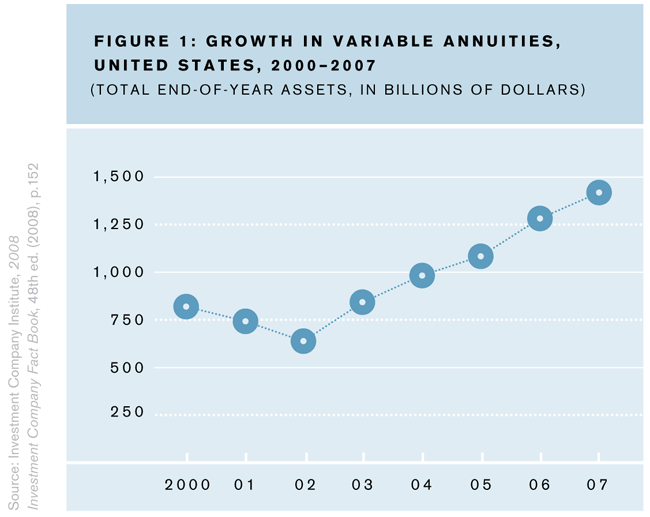
Companies now had to meet a growing demand for guaranteed investments while at the same time adjusting their risk-management and pricing strategies to better manage the risks exposed by volatile investment markets. More sophisticated pricing, valuation, and hedging techniques were developed as the market for guarantee products took off. From 2002–2007, total VA assets more than doubled to nearly $1.4 trillion (Figure 1).
For consumers, guarantees are attractive because they offer participation in equity or managed-fund growth in the underlying markets while providing protection against the risk of declining markets. With VA-style products, the guarantee is an option that carries a transparent and competitive price. In contrast to traditional payout annuities, these products offer policyholders the liquidity of their remaining account balance at any time.
Many customers who were burned by the bear market of 2000–2002 found guarantee products attractive, whether the product guaranteed protection of capital, minimum returns, the ability to lock in equity/fund performance, or lifetime income. And clearly, such guarantees are compelling once again, in the context of the subprime mortgage crisis and the ensuing financial fallout that has rocked financial markets the world over. Insurance companies have been honoring their VA guarantees in the face of sharp market downturns, providing confidence at a time when it has otherwise been sorely lacking.
Types of VA-style guarantee products
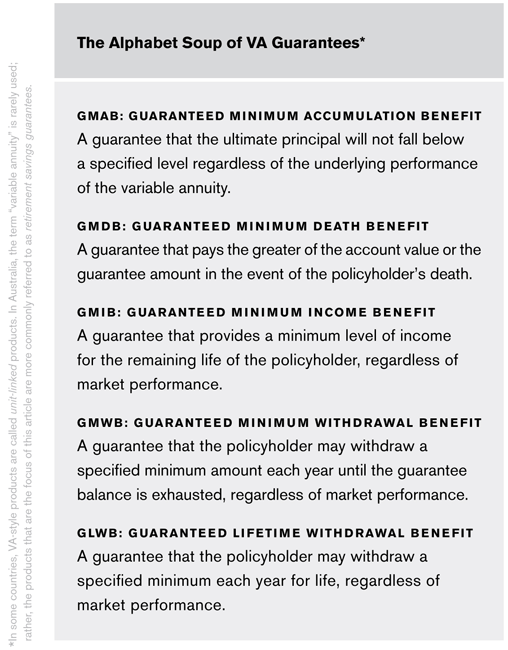
When applied to the retirement-plan sector, VA-style products offer a living benefit in the form of either a guaranteed minimum income or a guaranteed withdrawal amount. Three types of products are especially suitable for retirement plans: those with a guaranteed minimum withdrawal benefit (GMWB), a guaranteed lifetime withdrawal benefit (GLWB), or a guaranteed minimum income benefit (GMIB), each of which involves a managed payout program that ensures a minimum level of drawdown benefits for the policyholder.
One might think of GMWBs, GLWBs, and GMIBs as wealth-preservation or wealth-decumulation products, enabling the consumer to preserve wealth over the drawdown period in the event of longevity. They combine some of the advantages of traditional defined benefit (DB) and defined contribution (DC) retirement plans, allowing investors to control their assets and have access to them while also providing the security of a long-term minimum benefit floor. The success of VAs featuring such guarantees has stimulated the development of these products across a broader range of retirement plans, such as 401(k)s in the United States and superannuation funds in Australia.1
The guarantees can also be tailored to meet consumer needs in different market segments. For example, GMWBs can play a role in wealth accumulation during the period of the product life, typically the early years, during which accumulation may be their primary focus. As positive market returns produce growth in the underlying assets, the guarantee benefit balance ratchets up to match the growing account value, locking in market-based gains. However, there is a type of guarantee that is particularly designed as a wealth-accumulation product: the guaranteed minimum accumulation benefit (GMAB). In most markets, GMABs are attractive to younger investors who are at, or nearing, the height of their earning power and looking for a secure way to grow their wealth.2
Finally, guaranteed minimum death benefit (GMDB) products are available in some markets to meet the needs of consumers in various segments, particularly those engaged in estate planning.
A look at the regional markets
Partly as a result of the popularity of guarantees in the United States and Japan, together with a growing understanding of the products' value to consumers and an increasing acceptance of the effectiveness of risk-management strategies, companies active in the major European and other Asian markets began developing similar products for their policyholders.
The first market for VAs outside the United States was Japan, where the Netherlands-based company ING Life introduced variable annuities with a GMDB in 1999. Soon the Japanese company Mitsui began offering a GMAB. It didn’t take long for other companies to join the competition, and today Japan is second only to the United States in VA sales.3
In 2005, Hartford launched its SafetyNet product, a GMWB, in the United Kingdom. Other companies followed suit, and markets for guarantee products opened across continental Europe, Canada, Hong Kong, South Korea, Taiwan, and Australia.
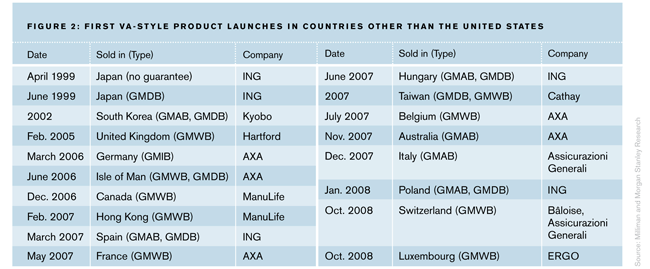
Market dynamics differ according to the local or regional investment culture, political-economic system, and population trends. In the United States, VAs tend to follow the same pattern as investments in general, with funds primarily invested in U.S. stocks, bonds, and mutual funds, and, as a recent trend, some diversification in the broader international markets. In Europe and Asia, guarantee products include a more global investment portfolio. There are some purely European funds, United Kingdom funds, and Japanese funds but, in a typical European VA for example, there is likely to be a more or less equal split between European investments and overseas investments. In general, countries with smaller national economies see a greater geographic diversification of investments, although one partial exception is Australia, where citizens who invest in the domestic market benefit from tax incentives.
Regional factors have implications for product design and risk management. Where population demographics are making it increasingly burdensome for the working-age population to support traditional retirement programs—e.g., in the United States and, even more so, in Japan and certain European countries—guarantees tailored for retirement plans are appealing as an income source for a future in which traditional pension benefits seem uncertain.4 Where regulatory conditions are difficult, especially regarding the hedging practices necessary for financial risk management (FRM), providers are finding a way around the restrictions, usually by underwriting and hedging the products outside the market countries themselves or by reinsuring the products internationally.
Japan - Today's second-largest variable-annuity market is dominated by single-premium products and a limited number of available fund choices. Sales of VA products in Japan began slowly but took off after Hartford entered the market in 2000 on the basis of a product-distribution relationship with major stockbrokers. After several years of explosive growth, dominated by foreign competitors, domestic companies have become increasingly involved. For example, Sumitomo Life and Tokio Marine Nichido Financial Life are now the leading Japanese players.
Unlike in the United States, where policy choices include a large number of funds, Japanese policyholders have only a handful of funds from which to choose. The available choices tend to be picked from funds that follow well-known indices.
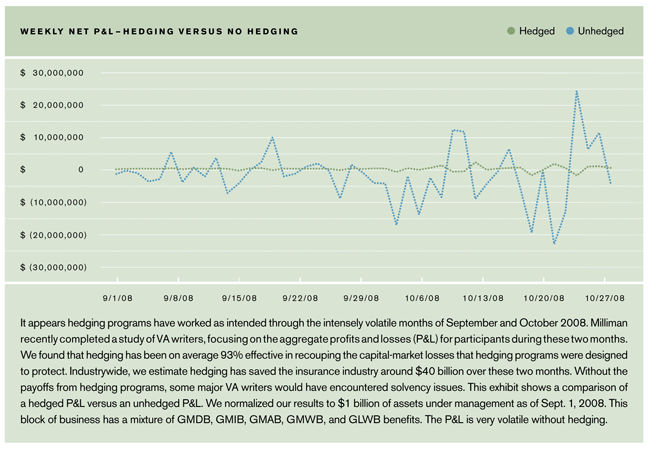
The most frequently sold guarantees to date have been GMABs, but market demographics are turning the tide more toward GMWBs and GLWBs, products that emphasize wealth decumulation. People older than 60 represent a high proportion of Japan's population—and hold an even higher proportion of the country's assets—and because they have already accumulated great amounts of wealth, they are a prime target for products that feature guaranteed withdrawal levels rather than guaranteed further accumulation benefits.
The same factor underlies the single-premium nature of Japanese guarantee products. An older population tends to have more accumulated wealth and is less likely to invest in the types of regular-premium (e.g., monthly) investment plans that are appropriate to younger people in their wealth-accumulating years.
Notwithstanding the rapid growth of the Japanese VA market—from less than $5 billion in 2002 to its present $158 billion—there is much potential for further growth. The Japanese have a lot of money in bank accounts earning very low interest rates, and higher-earning alternatives are attractive investments. At the same time, the traditional conservatism of Japanese investors makes the guarantee features of VAs appealing. Investors have the assurance that their principal is secure plus the chance to earn a higher return. This presents a positive opportunity for expanding the guarantee business.
Europe - Most of Europe (with the notable exception of Ireland5) shares the basic demographic condition of Japan, i.e., a burgeoning population near or into retirement and a declining proportion of younger adults. In the United Kingdom, for example, approximately one-third of the population, or 20 million people, is 50 or older, and that proportion is projected to increase.6 The large pool of savings accumulated by this older population is available for investing in programs that will decumulate assets in a measured, responsible way. Perhaps this explains why the majority of VA guarantees sold to date in the United Kingdom are wealth-decumulation products, although asset-accumulation products are also available and gaining momentum.
The trend is similar in the countries of northern continental Europe where VAs have begun to take hold. The emphasis in these markets, as in the United Kingdom, is on retirement or wealth-decumulation products, primarily GMWBs and GMIBs.
One sees a different pattern in southern Europe, mainly Italy and Spain, where wealth-accumulation VAs tend to predominate, usually in the form of GMABs. The main reason for this regional difference, despite similar age demographics, is that the southern countries have enjoyed more generous social security systems, and people rely on the state for their retirement needs more than in northern Europe. Similarly, the pattern in east-central Europe resembles that of southern Europe, i.e., with wealth-accumulation products predominating.
Regulatory concerns throughout much of Europe have made it necessary for companies selling VAs to set up cross-border underwriting and hedging operations. Thus Hartford's SafetyNet, sold in the United Kingdom, is underwritten from Ireland and hedged in the United States; AXA's TwinStar, sold in Germany, is also underwritten from Ireland and hedged in the United States, France, and partly in Germany.7 There has also been cross-border activity from Luxembourg into France, Germany, and Belgium.
The regulatory environment may soon change, however. The German government is currently considering new statutes that would facilitate the development of VAs wholly within Germany. The new regulations could be in place sometime during the first quarter of 2009. It seems logical that other European Union countries will follow suit.
One particular dynamic in the continental European market may affect VA product development in other markets. There appears to be a significant demand in several European countries for regular-premium savings products, in which people invest smaller amounts of money repeatedly over time rather than a large sum in a single premium (the norm in the United States and Japan). The target market for regular-premium products is generally people in their 30s and 40s who have less to invest but are accumulating wealth and beginning to plan for their retirement. Such products can be designed to address both the accumulation and decumulation phases of retirement planning—as, in fact, the AXA TwinStar product now being sold in Germany is designed to do.
Emerging markets in Asia
The major emerging Asian markets for guarantee products are South Korea, Taiwan, and Hong Kong. Hong Kong, the smallest of these (population 7 million), has already seen a number of VA product launches. Although there is a substantial number of potential investors with assets sufficient to make a market, it remains to be seen how many additional companies will offer guarantee products in Hong Kong and what the size of the market will be.
Larger markets will be found in South Korea and Taiwan, where VA offerings are taking shape primarily around GMAB and GMWB products sold to a predominantly younger clientele—the "salaryman" demographic, mid-career individuals who are just beginning to save for their retirement. Accordingly, the average policy size is relatively small and premiums tend to be of the regular-payment type. The market total in Korea is currently in the $10 billion to $20 billion range, and the market in Taiwan is just getting started.
Given the size of the national economies, investment portfolios must be heavily weighted toward global securities if they are to be diversified. Indeed, there are Korean and Taiwanese funds that are wholly denominated in foreign currencies and some funds that are essentially U.S. products sold directly in these countries.
In regulatory terms, South Korea is proving to be relatively problem free because the government regulators are receptive to hedging and other FRM practices common in the United States. In contrast, Taiwanese regulators immediately took a more stringent approach. Taiwan's statutes are vague about hedging for liabilities, and the regulators initially insisted that new legislation was needed to permit hedging as it is done in the United States. Products sold in Taiwan to date have had to be reinsured abroad. Now, however, it appears likely that the regulators might allow hedging in the near future, a welcome change that would put Taiwan on a regulatory footing similar to South Korea.
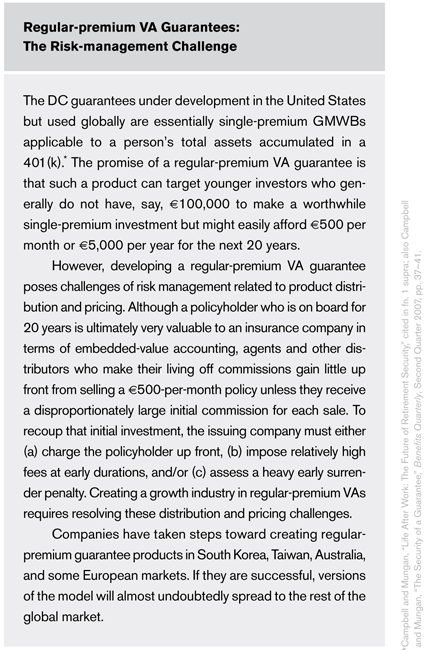
Australia - Australia offers a strong potential market for guarantee products because of the country's existing DC retirement structure, known to Australians as the superannuation system. That system requires every working person to set aside a minimum of 9% of his or her income by payroll deduction and invest it in a DC account. That has created an enormous pool of accumulated assets for which fund managers and insurance companies are now competing.
Those assets are held in several categories of funds, including retail-type funds offered by insurance and financial services companies and not-for-profit funds, some of which are called "industry funds" and are offered to members employed in specific industry sectors (retail, aviation, health services, etc.). Over the next 15 years, as the Baby Boom generation leaves the workforce, as much as $1.2 trillion, or 39% of total superannuation funds, will transition into retirement drawdown, presenting a tremendous opportunity for wealth-management organizations that can service fundholders' needs.8
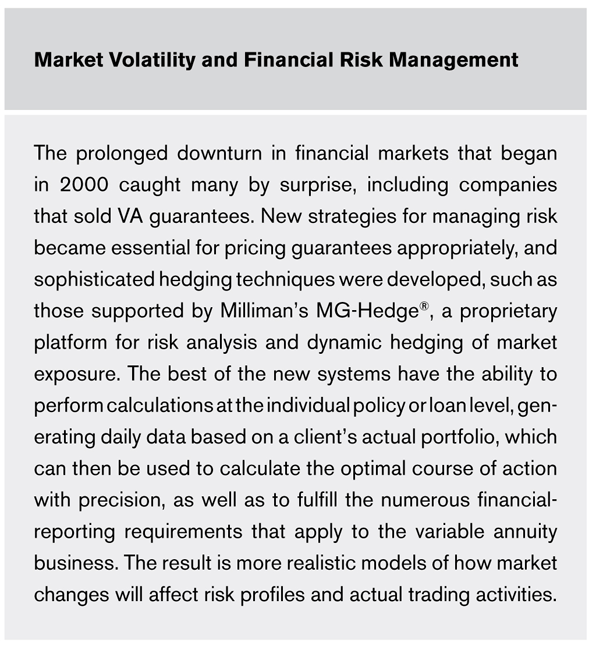
The Australian economy suffered less than others during the downturn of 2000–2002, so there was little concern about negative returns until more recently. The collapse of several high-profile Australian finance-related corporations, together with recent market events, has made the public aware of risk in the equity market. This realization comes as the Baby Boomers are moving from the accumulation mindset into the decumulation mindset—and starting to worry about outliving their savings. The traditional Australian risk-taking mentality is beginning to shift toward an approach that seeks capital preservation. With that shift comes a need for products that provide increased security.
There are, however, several hurdles to clear before guarantee products can occupy a big space in the Australian market:
- The distribution of guarantees provided by third parties through superannuation funds is likely to appear as a trend. The long-term nature of these guarantees will require a flexible and transparent operational structure to minimize counterparty risk and ensure that the fund protects its reputation and retains control over the product on behalf of its members.
- As the system is currently set up, accumulation and drawdown phases are separate, requiring product designs specific to each phase. An alternative may be to create an integrated guarantee, although technology and disclosure requirements may prove challenging.
- Fees for products in the retail market tend to be high, between 2% and 3% before adding guarantee costs. Fees charged by the not-for-profit funds, on the contrary, are generally below 1%. High fees mean higher end costs to consumers. This raises the question of whether retail providers can be competitive if they add new benefits at greater cost—or do they need to restructure to provide a better value proposition?
- Guarantee products are something new, and regulatory treatment is uncertain. When AXA launched the first guarantee product in Australia in November 2007, the guarantee was structured outside the life insurance business, shifting many of the responsibilities for oversight onto the shoulders of the fund trustees.9
These problems are not insoluble, and if providers can develop products that clear the regulatory hurdles and keep the fees manageable, there is a rich opportunity in Australia.
Global roundup
The global market for guarantee products seems to hold much promise, but it also challenges companies to develop new approaches to their business if they are to succeed.
Challenges - The first challenge is to recognize that there is not one global market, but many national and regional markets, and to understand what works in each and what does not:
- What are the key population trends, and how do they affect market demand in terms of accumulation/decumulation products?
- What are the prevailing tendencies in the local investment culture, and what do they suggest about effective product design?
- How are customer expectations shaped by the existing framework of insurance products and pension benefits in the region? Can product design incorporate the elements of these existing products that customers find attractive while improving parts they don’t?
- With respect to fee structures, which markets are particularly price sensitive (e.g., the United States, Australia, and the United Kingdom), which are not so price sensitive (e.g., Asia and southern Europe), and how does price sensitivity affect product design and distribution?
- How does a country's tax climate affect the value of guarantee products, and how can products be designed so as to maximize any available tax benefits?
Companies entering multiple markets are wise to think in terms of not only a single, homogeneous product. The business case for investing in FRM infrastructure is strongest when a company positions itself to meet customer needs across a variety of market segments. The valuable business proposition, then, rests in the ability to develop one FRM infrastructure that meets those different needs with different VA products.
The second challenge is to master the complexities of risk management in the global context. Hedging strategies must be global in scope, accounting for multiple currency exposures and risk factors peculiar to each individual country’s market.
Managing large multinational funds means trading around the clock in the world's major financial exchanges, each with its own rules and standards. It requires clear and constant communication between a technical staff that is competent on the level of global strategies and FRM, and local staffs who understand the various economies and capital markets, know which banks to talk to about which instruments, and have cultural credibility among the people with whom they deal.
What goes around
The globalization of the guarantee market will produce reciprocal influences in product development. Although different regional markets require their own solutions, lessons learned in one market can lead to new applications elsewhere. By spreading outward from the American market, guarantee products are finding new forms that can be imported into the United States. For example, if regular-premium guarantees succeed in Europe, Korea, Taiwan, and Australia, similar products may sprout in the United States, where they could be applied to the wealth-accumulation phase of individual retirement programs. And no doubt there is much for American fund managers to learn from their counterparts around the world about how to truly diversify their holdings globally.
Sam Nandi is the leader of the actuarial team within Milliman's Financial Risk Management practice in Chicago.
Tamara Burden is a senior consultant with the Financial Risk Management practice in the Chicago office of Milliman.
Gary Finkelstein is leader of the Financial Risk Management practice in the London office of Milliman.
Rikiya Ino is a principal and senior consultant in the Tokyo office of Milliman.
Wade Matterson is a leader of the Financial Risk Management practice in the Sydney office of Milliman.
Peter Sun is a senior consultant with the Financial Risk Management practice in the Chicago office of Milliman.
1 Dan Campbell and Ken Mungan, "Life After Work: The Future of Retirement Security," Insight magazine, Autumn 2006.
2 It should be noted, however, that GMABs are sometimes also sold to older consumers, especially in Japan.
3 Rikiya Ino, "Variable Annuity Market in Japan: The Sun Also Rises," Aug. 1, 2006.
4 For a discussion of how demographics affect the pension systems of various countries, see Malcolm Gladwell, "The Risk Pool," in The New Yorker, Aug. 28, 2006.
5 See Gladwell, "The Risk Pool," for a discussion of the bulge in Ireland’s working-age population, largely attributable to the lowering of legal barriers to contraception and the consequent decline in birth rates.
6 U.K. Statistics Authority, National Statistics Online.
7 Farooq Hanif, Gary Finkelstein, Jon Hocking, and Joshua Corrigan, "Life Insurance: Global Variable Annuities," Morgan Stanley/Milliman research paper, Dec. 7, 2007, p. 14.
8 Wade Matterson, "Risk in Retirement: Impact of the Market Downturn and Implications for Retirees and Product Providers," Milliman research paper, July 2008. In addition to the two approaches mentioned, there is also a substantial self-managed sector of the retirement-funds market, which is more fragmented and therefore harder for companies offering guarantee products to penetrate.
9 AXA's North, a regular-premium GMAB, is available in both a superannuation version and an ordinary money version, indicating that the trend in Australia may be to offer guarantees into both retirement savings plans and regular retail investment products.
About the Author(s)
Wade Matterson
Peter H. Sun
Contact us
We’re here to help you break through complex challenges and achieve next-level success.
Contact us
We’re here to help you break through complex challenges and achieve next-level success.
Cultivating confidence: The emerging global market for VA-style guaranteed benefits products
The success of retirement-savings products such as variable annuities (VAs) with guaranteed benefits in the United States and Japan—and the ability of these products to stand up to intense market volatility, as we saw in September and October of 2008—has caught the attention of insurance companies and policyholders in the global market.